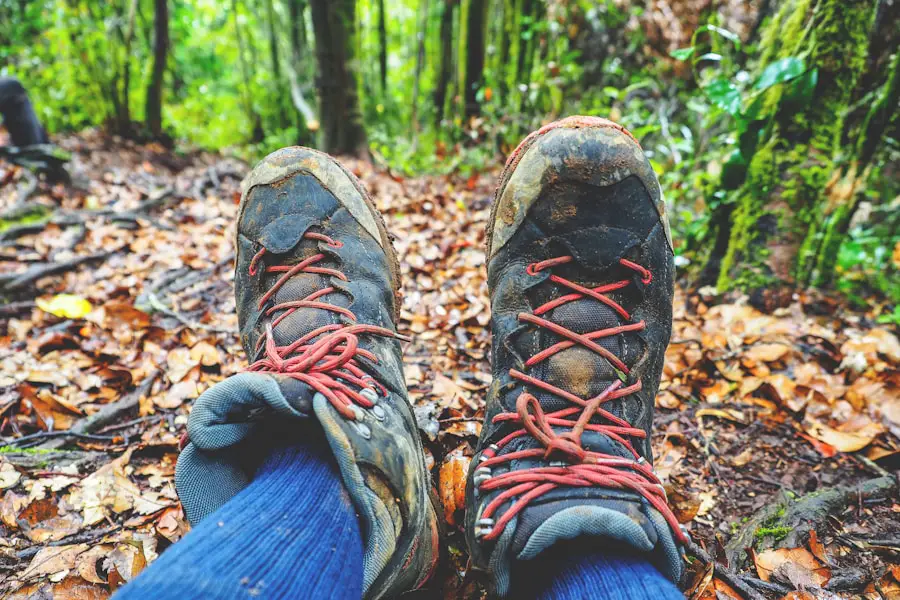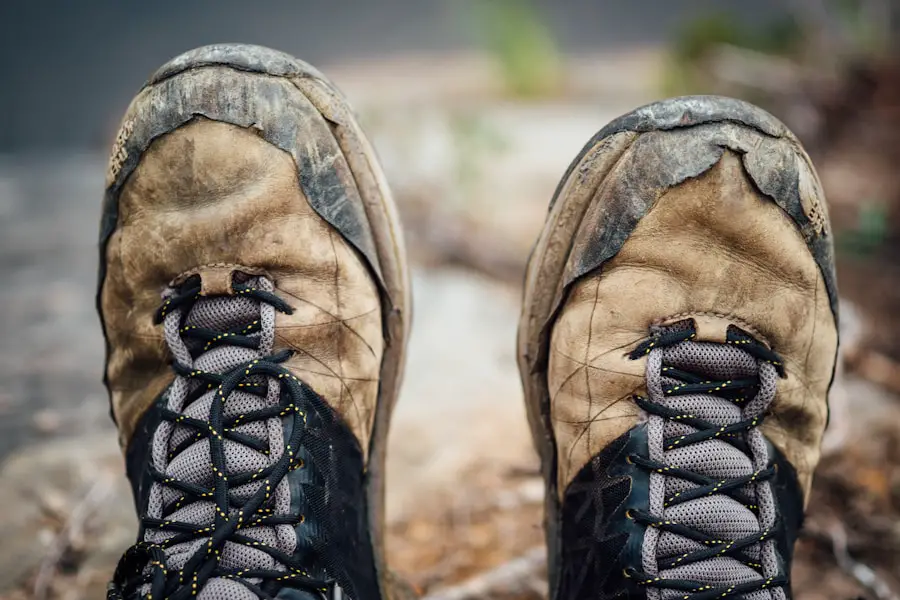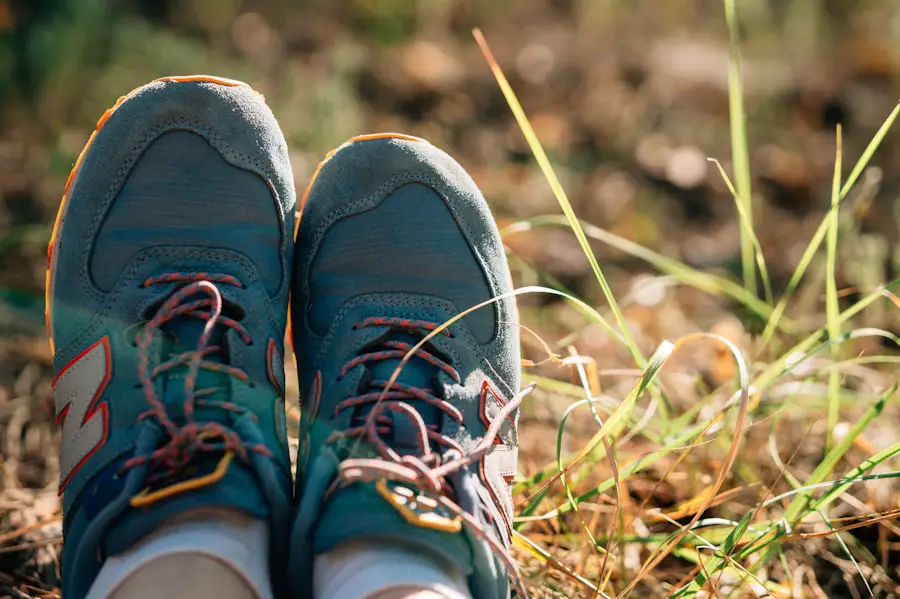Footwear, particularly athletic shoes and boots, undergoes a significant amount of stress during their lifespan. One of the most apparent indicators of wear and tear is the visible degradation of the shoe’s materials. This can manifest in various forms, such as fraying seams, worn-out laces, or even the outer fabric beginning to lose its integrity.
For instance, a running shoe that has been used extensively may show signs of the upper mesh fabric becoming thin or developing small holes. These signs not only affect the aesthetic appeal of the shoe but can also compromise its functionality. Another critical aspect to consider is the sole of the shoe.
Over time, the tread pattern can become less defined, leading to a reduction in grip and stability. The midsole, which provides cushioning and support, may also begin to compress or break down, leading to a less responsive feel during activities. When inspecting footwear for signs of wear and tear, it is essential to look for these indicators, as they can significantly impact performance and comfort.
Regularly assessing your shoes can help you determine when it’s time for a replacement, ensuring that you maintain optimal foot health and performance.
Key Takeaways
- Signs of Wear and Tear: Look for fraying, fading, or thinning of the material, as well as any visible damage to the sole or upper of the shoe.
- Loss of Traction: Pay attention to any slipping or sliding on different surfaces, which could indicate a loss of traction in the shoe.
- Decreased Comfort and Support: If you notice a decrease in cushioning or arch support, it may be time to replace your shoes.
- Visible Damage: Check for any cracks, tears, or punctures in the shoe that could compromise its structural integrity.
- Unpleasant Smells: Foul odors could indicate a buildup of bacteria or mold inside the shoe, signaling the need for a replacement.
- Changes in Fit: If your shoes feel looser or tighter than usual, it could be a sign of wear and tear affecting the fit.
- Persistent Foot Pain: If you experience ongoing discomfort or pain while wearing your shoes, it may be time to invest in a new pair.
- Reduced Waterproofing: If your shoes no longer repel water as effectively as they used to, it’s a sign that the waterproofing has worn off and they may need to be replaced.
Loss of Traction
Traction is a crucial element in footwear, especially for those engaged in sports or outdoor activities. A shoe’s ability to grip the ground can significantly influence performance and safety. As shoes age, the rubber compounds in the outsole can wear down, leading to a noticeable loss of traction.
This deterioration can be particularly dangerous in wet or uneven conditions, where slipping can result in injuries. For example, trail runners may find that their shoes no longer provide the grip needed on rocky or muddy terrain, increasing the risk of falls. The tread pattern plays a vital role in how well a shoe can maintain traction.
Over time, the lugs that provide grip can become flattened or worn down, reducing their effectiveness. In some cases, this loss of traction may not be immediately apparent until the wearer encounters challenging surfaces. Athletes should regularly evaluate their footwear for signs of reduced grip, especially if they notice an increase in slips or instability during their activities.
Investing in new shoes when traction diminishes can prevent accidents and enhance overall performance.
Decreased Comfort and Support

Comfort and support are paramount when it comes to footwear, particularly for individuals who spend long hours on their feet or engage in high-impact activities. As shoes age, the cushioning materials within them can compress and lose their ability to absorb shock effectively. This degradation often leads to a noticeable decrease in comfort levels, which can manifest as soreness or fatigue during or after use.
For instance, a pair of running shoes that once felt plush may start to feel hard and unforgiving after several months of regular use. Support is another critical factor that diminishes over time. The arch support provided by insoles can flatten out, leading to inadequate support for the foot’s natural structure.
This change can result in discomfort and even contribute to conditions such as plantar fasciitis or other overuse injuries. It is essential for wearers to pay attention to how their shoes feel during use; if discomfort becomes a regular occurrence, it may be time to consider replacing them. Prioritizing comfort and support not only enhances performance but also contributes to long-term foot health.
Visible Damage
| Location | Number of Visible Damage |
|---|---|
| Living Room | 5 |
| Kitchen | 3 |
| Bedroom | 2 |
| Bathroom | 1 |
Visible damage is often one of the most straightforward indicators that footwear needs replacing. This damage can take many forms, including cracks in the sole, peeling materials, or significant scuff marks on the upper part of the shoe. For example, hiking boots that have been subjected to rugged terrain may develop deep cuts or abrasions that compromise their structural integrity.
Such damage not only affects the shoe’s appearance but can also lead to functional issues, such as reduced waterproofing or support. In addition to external damage, internal wear can also be a concern. The lining of a shoe may begin to tear or separate from the upper material, leading to discomfort and potential blisters.
Furthermore, if the cushioning material inside becomes dislodged or unevenly compressed, it can create pressure points that lead to pain during use. Regularly inspecting footwear for visible damage is crucial; addressing these issues promptly can prevent further deterioration and ensure that shoes continue to perform effectively.
Unpleasant Smells
Unpleasant odors emanating from footwear are often an overlooked sign that it may be time for a replacement. Shoes are subjected to moisture from sweat and environmental factors, creating an ideal breeding ground for bacteria and fungi. Over time, these microorganisms can proliferate within the shoe’s interior, leading to persistent odors that are difficult to eliminate.
For instance, athletic shoes worn during intense workouts may develop a strong smell that lingers even after washing. While some odors can be mitigated through cleaning and proper drying techniques, persistent smells often indicate that the materials have absorbed too much moisture or bacteria over time. In such cases, replacing the shoes may be the most effective solution.
Not only does this improve hygiene, but it also enhances comfort by ensuring that the interior environment remains fresh and supportive for the feet. Additionally, investing in moisture-wicking socks and using foot powders can help reduce odor buildup in new footwear.
Changes in Fit

As shoes age, they may undergo changes that affect their fit and overall comfort.
One common issue is stretching; materials like leather or synthetic fabrics can loosen over time due to repeated wear. This stretching can lead to a shoe that feels too loose or lacks the necessary support for activities like running or hiking.For example, a pair of once-snug sneakers may start to feel baggy around the heel or midfoot after several months of use. Conversely, some shoes may shrink slightly due to exposure to moisture or heat during washing or drying processes. This shrinkage can create discomfort and restrict movement, particularly if the shoe was already snug at purchase.
It is essential for wearers to regularly assess how their shoes fit; if they notice significant changes that affect comfort or performance, it may be time to consider purchasing a new pair. Ensuring a proper fit is crucial for maintaining foot health and preventing injuries.
Persistent Foot Pain
Foot pain is often a clear signal that footwear is no longer providing adequate support or cushioning. Individuals who experience ongoing discomfort while wearing their shoes should take this as a serious indication that it might be time for a replacement. Conditions such as arch pain, heel pain, or general soreness can arise from worn-out shoes that fail to provide the necessary support for various foot types.
For instance, runners who experience shin splints or knee pain may find that their shoes have lost their shock-absorbing capabilities. Persistent foot pain can also stem from inadequate fit; if shoes are too tight or too loose, they can create pressure points that lead to discomfort over time. It’s essential for individuals experiencing foot pain to evaluate their footwear critically and consider whether it might be contributing to their issues.
Consulting with a podiatrist or footwear specialist can provide valuable insights into whether new shoes are needed based on specific foot conditions and activity levels.
Reduced Waterproofing
For those who frequently encounter wet conditions—whether through hiking in rain-soaked environments or running through puddles—waterproofing is an essential feature of footwear. Over time, however, even high-quality waterproof materials can lose their effectiveness due to wear and tear. This reduction in waterproofing can lead to soggy socks and uncomfortable experiences during outdoor activities.
For example, hiking boots designed with Gore-Tex membranes may begin to allow water penetration after extensive use. The loss of waterproofing often occurs gradually; initial signs may include dampness inside the shoe after exposure to wet conditions. If left unaddressed, this issue can lead to more significant problems such as blisters or fungal infections due to prolonged moisture exposure.
Regularly checking for signs of reduced waterproofing—such as visible cracks in the material or water pooling inside—can help users determine when it’s time to invest in new footwear designed for wet conditions. Ensuring reliable waterproofing not only enhances comfort but also protects against potential health issues related to wet feet.
If you’re planning your next hiking adventure, it’s important to know when to replace your hiking shoes to ensure a safe and comfortable journey. For more tips on preparing for your trip, check out this article on how to choose the best travel guidebook to help you navigate your destination with ease. Remember to also pack essential items like universal travel adapters and a reliable travel toothbrush for a smooth and enjoyable journey.
FAQs
What are the signs that indicate it’s time to replace hiking shoes?
Some signs that indicate it’s time to replace hiking shoes include worn out treads, visible cracks or tears in the shoe material, loss of cushioning and support, and discomfort or pain while wearing the shoes.
How often should hiking shoes be replaced?
The lifespan of hiking shoes can vary depending on factors such as frequency of use, terrain, and care. On average, hiking shoes should be replaced every 500-1000 miles of use.
Can hiking shoes be repaired instead of replaced?
In some cases, minor repairs such as re-gluing soles or patching small tears can extend the life of hiking shoes. However, if the shoes are significantly worn out or damaged, it’s often more practical to replace them.
What are the consequences of not replacing hiking shoes when needed?
Continuing to use hiking shoes that are worn out or damaged can lead to discomfort, pain, and even injury. Worn out treads can also compromise traction and increase the risk of slipping on uneven terrain.
How can I prolong the lifespan of my hiking shoes?
To prolong the lifespan of hiking shoes, it’s important to clean and dry them properly after each use, store them in a cool, dry place, and avoid exposing them to extreme temperatures or harsh chemicals. Regularly inspecting the shoes for signs of wear and tear can also help identify when it’s time to replace them.
